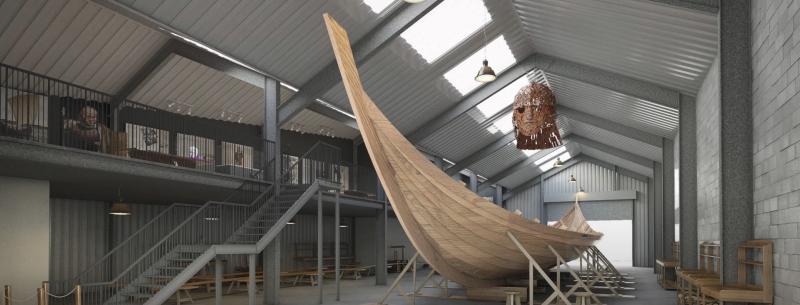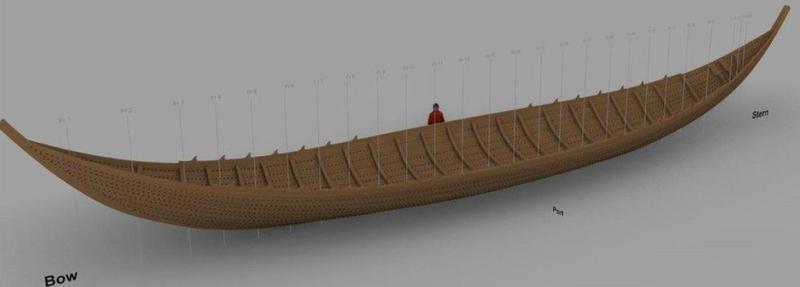
Artist’s Conception of the Recreated Sutton Hoo ship
I recently watched “The Dig,” a new movie on Netflix, starring Carey Mulligan and Ralph Fiennes about the excavation of the Sutton Hoo ship-burial in Suffolk, England. Now the Sutton Hoo Ship’s Company is undertaking to recreate the great king’s ship in a specially built shed in Woodbridge, just across the River Deben from Sutton Hoo.
In 1939, the widowed landowner, Edith Pretty, hired a local excavator and archeologist, Basil Brown, to excavate several mysterious mounds on her estate. Within a few months, Brown uncovered a huge ship-burial dating from the early AD 600s, which is generally believed to be the grave of King Rædwald.
At almost 90′ long with as many as 40 oarsmen, the ship was the largest vessel of the period ever discovered and predated the arrival of the Vikings by almost two centuries. Also found in a burial chamber on the ship was an incredible treasure of grave goods, including Byzantine silverware, sumptuous gold jewelry, a lavish feasting set, and, an ornate iron helmet. The find has been referred to as variously as one of “the greatest archaeological discoveries of all time” as well as “Britain’s Tutankhamun.”
The movie, “The Dig,” tells the story of the excavation with considerable charm and grace. The acting is wonderful and the cinematography is beautiful. The script touches on themes of mortality, class prejudice, love, and family. One significant but silent character in the movie, providing a vivid backdrop for the story, is what remains of the ship itself.
In fact, the ship was gone for centuries before Basil Brown turned over the first spade of soil on the barrow. The ship had rotted away long ago, but remarkably, left behind a cast of each plank and frame imprinted in the hardpacked sandy soil.
The Sutton Hoo Ship’s Company has built a half-scale version of the ship and now intends to build the full-scale ship in all her glory.

National Historic Ships describes the project: The team will build the Saxon ship using authentic ship-building methods with the help of marine archaeologists, ship architects, shipwrights, and experts in green woodworking. Together with strong academic support from the Universities of York and Southampton the team will ensure detailed records are kept at every stage of the build. Along with professional shipwrights overseeing critical parts of the build, the team will engage with apprentices and students from the International Boatbuilding Training College at Lowestoft to benefit from learning on the build.
A short video about the project:
The Sutton Hoo Ship- a short history, narrated by Martin Carver

No idea of seakeeping ability but that is one elegant hull.
A visual treat. Thanks!
I can only assume that the bar at the mouth of the River Deben was less of a hazard to navigation back then. It requires very careful navigation nowadays with strong currents over shifting shingle banks. Perhaps they had river pilots in those days as well?
The Sutton Hoo really is an absolute visual treat! I suppose the tall bow and stern make for easier going in taller waves?
Pingback: Digging for Britain